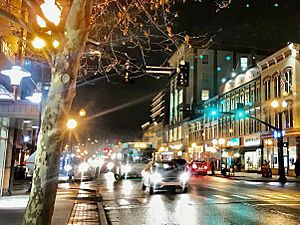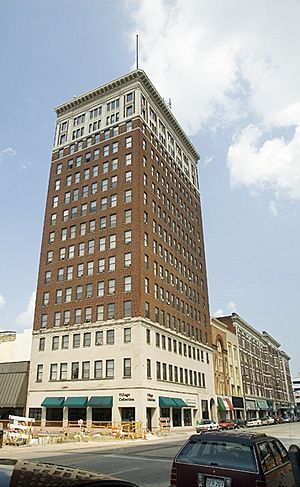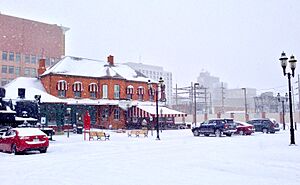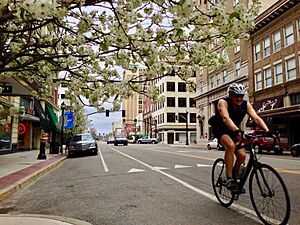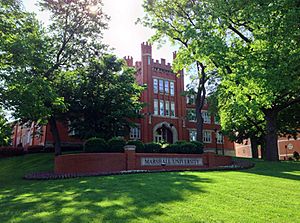Cityscape of Huntington, West Virginia facts for kids
Huntington, West Virginia, has a busy downtown area. It is located near the Ohio River. This area has wide streets that form a neat grid pattern. Another important business area is Old Central City, which is famous for its many antique shops and a well-known bakery.
Many big factories are located along the Ohio River. These include the Steel of West Virginia complex and Special Metals. The river was very important for building these industries a long time ago. However, in the 1970s, many factories started to close down. This caused Huntington's population to shrink.
Luckily, the city found new jobs in the service industry. Two large hospitals, St. Mary's and Cabell-Huntington, have grown a lot. They have doubled in size over the last twenty years, creating many jobs.
Huntington also has many historic buildings. Most of them were built when the Baltimore and Ohio Railroad and the Chesapeake and Ohio Railway were booming. Some cool buildings include the 12-story St. James Building, which has huge columns and a fancy lobby. The West Virginia Building is a tall, red brick building. It used to be the tallest building in the state! Many other interesting buildings are found downtown, like the beautiful Guaranty Bank and Trust Building. Rich families who owned railroads built large homes and mansions on the hills behind the city.
Contents
Downtown Huntington
Making the City New Again
In the 1960s and 1970s, Huntington started big projects to make the city new again. This is called urban renewal. Several blocks of buildings were torn down. One block became the Huntington Civic Center. Another block got a Wendy's restaurant and an apartment building.
Two large blocks remained an empty parking lot for almost 30 years. People called this area the "Superblock." Later, a Chi-Chi's Mexican restaurant opened on a small part of it. Other projects from this time included the Radisson Hotel and Heritage Station. They also created the 9th Street Plaza, which was only for people walking.
A new Holiday Inn hotel was built in 1998. Then, in 2004, work started on Pullman Square. This new shopping and entertainment area took up the rest of the Superblock. It opened later that same year.
In 2006, the 9th Street Plaza was improved. It now has wide sidewalks and outdoor seating for restaurants. It also has two lanes for cars and angled parking in the middle. Brick pedestals were built to hold two tall spires from the old 6th Street Bridge. These spires are at the entrances to the plaza. The new 9th Street Plaza reopened in December 2006. It now connects the Pullman Square area with the rest of downtown.
Because of these new projects, many buildings downtown have been fixed up. New shops and apartments are being built. For example, the 900 block of 3rd Avenue, which used to be empty, is now full of rented shops. Old metal coverings have been removed from buildings to show the original brickwork. In 2007, a cooking store called Le Cook Store opened across from Pullman Square. A cooking school also opened, offering classes and food tastings. A jewelry store, C.F. Reuschlein Jewelers, opened on the same block.
A Fresh Look for Downtown
In 1999, a plan was shared to improve the streets. Some of these ideas were later used for Pullman Square and the 9th Street Plaza. The study said that the "old downtown" with big department stores was gone. It suggested that successful downtowns now need people to live in the upper floors of buildings. Then, shops, restaurants, and offices would follow.
Some of the ideas included:
- Making downtown Huntington better to improve the whole region.
- Giving more money to programs that help downtown.
- Adding welcoming signs at the 8th and 10th Street underpasses.
- Developing the "Superblock" (which became Pullman Square).
- Encouraging people to live in apartments above downtown shops.
- Helping existing shops and adding new ones, restaurants, and fun places.
- Bringing more offices downtown.
- Making downtown look nicer.
- Making it easier for cars and people to move around.
- Making sure there is enough easy parking downtown.
- Creating a reason for people to visit downtown. This could be by combining history, museums, music, and other special things.
Heritage Station
During the urban renewal projects, people wanted to save historical buildings. They raised money to create a special shopping, dining, and entertainment area. The idea was to move old buildings from other parts of Huntington to one spot. This was a new idea to bring people downtown.
Heritage Village, now called Heritage Station, opened on September 2, 1977. It includes an old Baltimore and Ohio Railroad passenger station from 1892. It also has a B&O Railroad freight house from 1911 and the Bank of Huntington building from 1871. The railroad buildings were no longer used after 1965. The railroad even gave two old boxcars. A historical group donated a steam engine and a Southern Railway sleeping car.
Heritage Station is now a popular place. It has many unique, local shops. You can find artisan gifts, a local market, a coffee shop, a wine bar, a cigar store, a beer and cheese shop, and vintage clothing.
Pullman Square
Pullman Square is a modern shopping and entertainment area in downtown Huntington. It is located on what used to be the "Superblock." This large area was cleared in 1970 as part of the urban renewal project. Pullman Square has one- and two-story buildings. It includes a 16-screen movie theater called Marquee Cinemas. There are also many other shops and restaurants.
Old Main Corridor
The Old Main Corridor project aims to connect downtown Huntington with Marshall University. The idea is to make 4th Avenue a nicer place for walking and biking. The plan was updated in 2006. It wants to build on the success of Pullman Square.
The original plan from 2003 included gardens and a public plaza. But these were removed to save money. The new design is expected to cost about $2.5 million. Money has been found for the section between 9th and 10th streets, and work started in 2007. More money is being requested for the section from Hal Greer Boulevard to 12th Street.
The final project will repave 4th Avenue. It will also reduce the number of car lanes from four to two. There will be one lane in each direction with left-turn lanes. Bike lanes will be added from Hal Greer Boulevard to 6th Street. On-street parking will stay the same. New trees and street lights, like those near Pullman Square, will be installed. Other safety improvements, like new sidewalks and curb extensions, will make it safer for people walking.
Kinetic Park
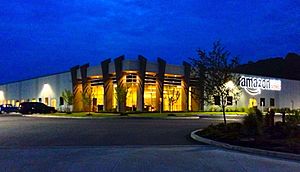
Kinetic Park is a large technology park in Huntington, covering about 95 acres. It is located near Interstate 64. The park has two main parts. The lower part is for regular businesses, and the upper part is for technology companies and startups. There are currently many spots available for both types of businesses.
Commercial Businesses
The lower part of Kinetic Park has over 12 acres for commercial businesses. These businesses are meant to serve the people working in the Technology Park and nearby areas. They include restaurants, hotels, banks, and other shops. Currently, there is a Bob Evans restaurant and a TownePlace Suites by Marriott hotel there.
Technology Companies
The upper part of Kinetic Park has almost 23 acres for technology businesses. These companies want a special location in a modern office park with high-tech equipment. The first businesses, Huntington Dermatology and Sullivan Webb, were expected to move into a new building in 2007. Amazon.com started building a new customer support call center here in July 2011. This new center replaced their old one in downtown Huntington. The building was finished in October of that year and opened soon after.
Marshall University
Marshall University has many old and new buildings. The tallest buildings are the Twin Towers. The oldest building is Old Main. In 2007, work was planned to begin on the Health and Wellness Center. This project includes two new dorm buildings and a parking garage.
Images for kids
-
Buildings under renovations along 3rd Avenue across from Pullman Square. The building at left had its façade removed since it was badly damaged during a 1950-1960s era "renovation", but the reinstallation of an earlier resemblance is remarkable. The building at right is slated to become The Cook Store, a high end kitchen store.
-
Empire News and Books at Pullman Square
-
Along 4th Avenue in downtown Huntington. Huntington Arcade is visible to the left and Keith Albee is to the right.


